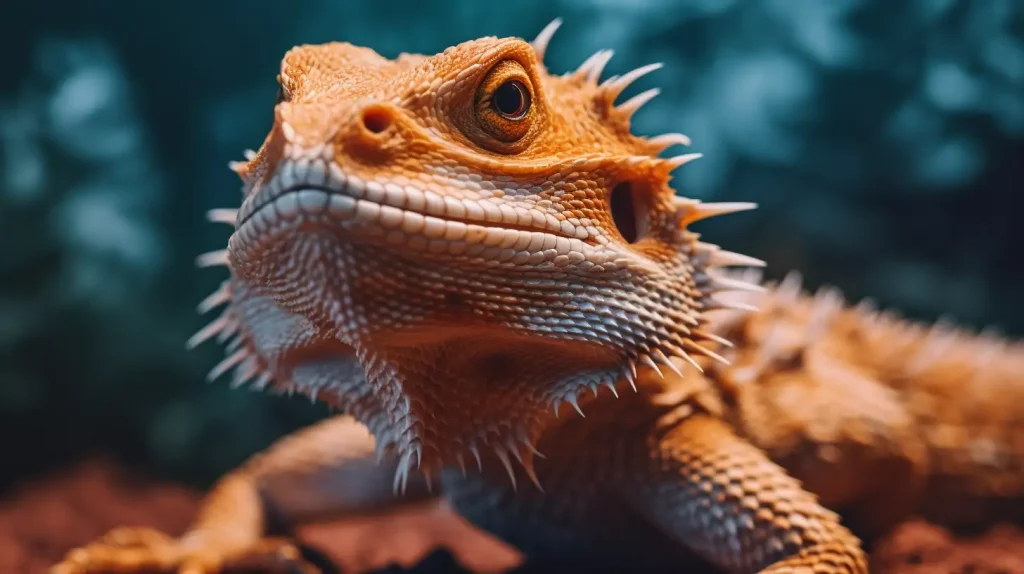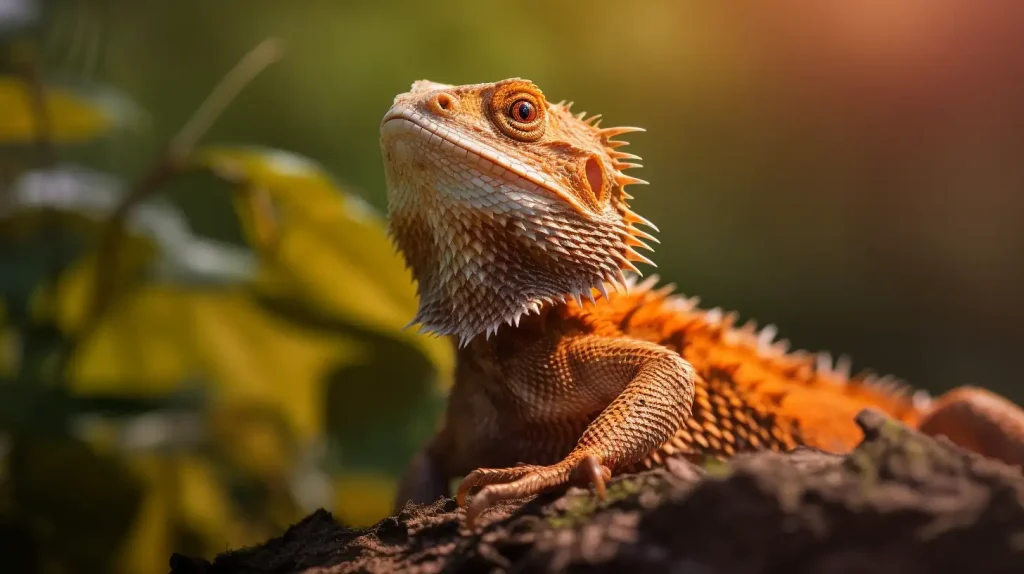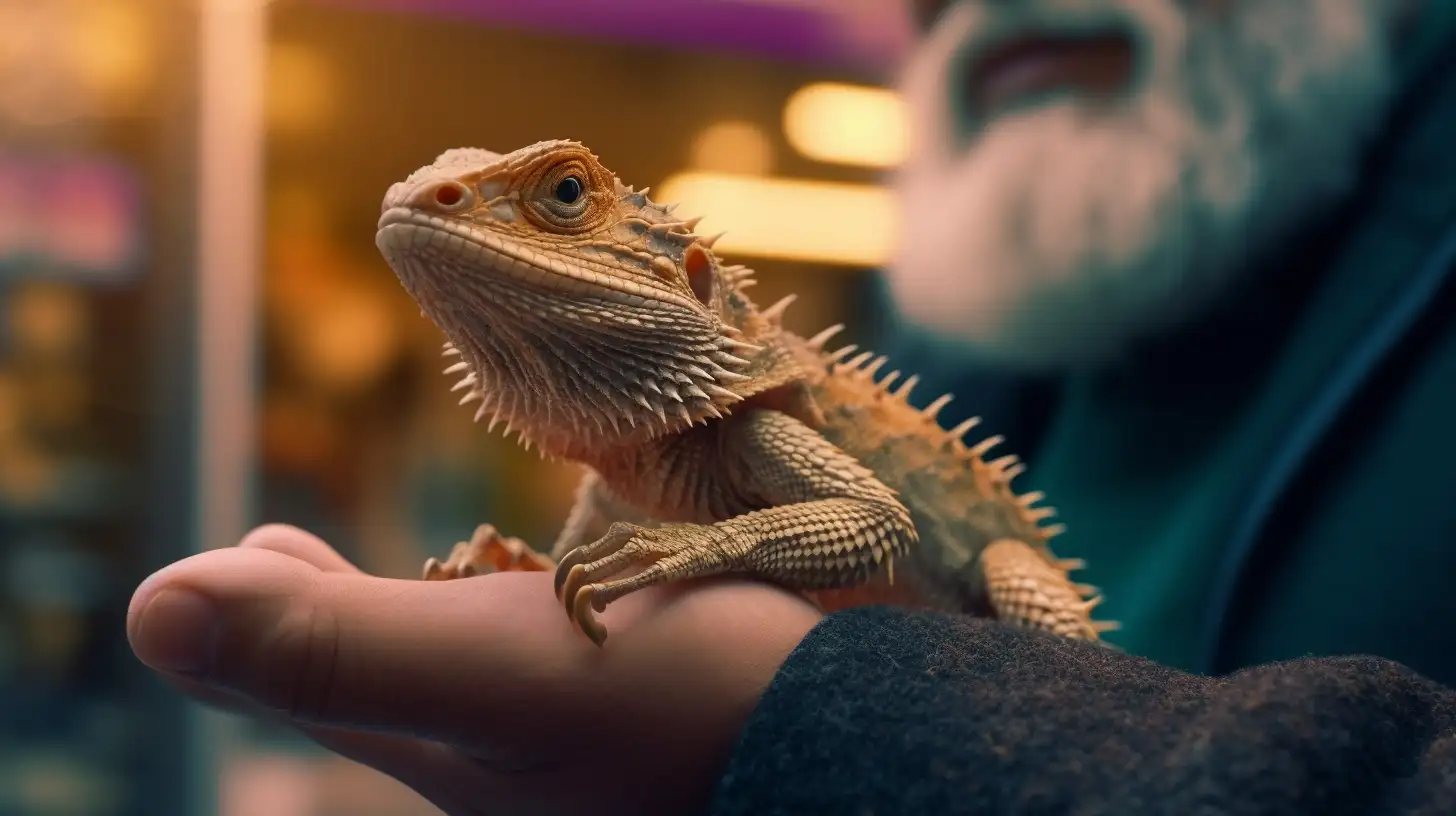Table of Contents
Before answering the question of do bearded dragons eat their shed, let’s quickly discuss what shedding is. Shedding is a part of the natural order of things when it comes to reptiles . Indeed, all reptiles shed their skin at some stage. As they grow, reptiles’ skin becomes tight and therefore needs to be replaced with new skin that can accommodate their new body size. Bearded dragons
. Indeed, all reptiles shed their skin at some stage. As they grow, reptiles’ skin becomes tight and therefore needs to be replaced with new skin that can accommodate their new body size. Bearded dragons are no exception to this rule of nature. The creatures may also feel the need to shed if their skin has become damaged with some sort of injury such as a scratch or scrape, for example. The frequency with which bearded dragons shed changes as they age:
are no exception to this rule of nature. The creatures may also feel the need to shed if their skin has become damaged with some sort of injury such as a scratch or scrape, for example. The frequency with which bearded dragons shed changes as they age:
- A hatchling can shed every 1-2 weeks due to excessive growth
- A juvenile can shed every 6-8 weeks while still growing
- A fully grown adult can shed several times a year.
Note: While young and growing, the shedding process can take anything from a few days up to two weeks to complete. In adult beardies, the shedding process can span three weeks.
There are several signs that a bearded dragon is about to shed, and as an owner it is important to pay attention to these behavioral changes. The beardie’s appearance will change, with its skin looking duller and, on occasion, eyes bulging (this helps to loosen the skin around the eyes to assist with shedding). If your dragon appears to be irritable, it is advisable not to excessively handle it. Shedding is a hugely energy sapping process for the reptile and fatigue, lethargy, and irritability may result from it.
Important: Under no circumstances should you pull the shedding off your bearded dragon yourself.
Do Bearded Dragons Eat Their Shed, and If So, Why
During and after the shedding process you might notice something strange. Yes, your bearded dragon may eat its shed skin. This is not to say that all beardies do this as they are, at the end of the day, all individual animals and their behavior differs from one to the other. However, eating their shedding is a completely normal and natural thing for a bearded dragon to do. There are a number of reasons for a bearded dragon to eat its shedding. Here are a couple of the main ones:
Predators
In a bearded dragon’s natural habitat, there are many predators – larger lizards, snakes , and birds of prey, to name but a few. One of the reasons a beardie will eat its shedded skin is to avoid giving away its location to these threats. This behavior carries over to pet bearded dragons as the instinct is hard-wired.
, and birds of prey, to name but a few. One of the reasons a beardie will eat its shedded skin is to avoid giving away its location to these threats. This behavior carries over to pet bearded dragons as the instinct is hard-wired.
Nutrients
A second reason for pet beardies to eat their shed is something else that is instinctive to them. There are nutrients, including all-important calcium, in the old skin. Many lizards do this, as the act of shedding is a stressful and energy-consuming process and any extra energy that can be gained from their old skin is best not to be wasted. It becomes a cycle that is beneficial to the growth and development of a bearded dragon; the old skin helps provide the energy required to function healthily after the new skin has grown. In addition, a lot of the time food is scarce in the wild and the compulsion to eat shedding is an evolutionary advantage.
do this, as the act of shedding is a stressful and energy-consuming process and any extra energy that can be gained from their old skin is best not to be wasted. It becomes a cycle that is beneficial to the growth and development of a bearded dragon; the old skin helps provide the energy required to function healthily after the new skin has grown. In addition, a lot of the time food is scarce in the wild and the compulsion to eat shedding is an evolutionary advantage.

Health Implications of Eating Shed Skin
The instinctive behavior of bearded dragons consuming their shed skin sparks a question of health implications. Is this practice actually safe, or are there hidden health risks involved? Let’s unravel the truth.
Generally speaking, it is completely normal and safe for bearded dragons to eat their shed skin. This behavior in the wild provides them with an extra source of nutrients, particularly calcium, which is crucial for their health. In their natural habitat, the ingestion of their shed skin allows them to gain back some of the energy lost during the shedding process, making it an evolutionary advantage.
However, in captivity, it’s important to ensure that the environment is clean and the shed skin is free of any potential contaminants. Subpar conditions can potentially lead to bacterial or fungal growth on the shed skin. If a bearded dragon ingests this, it could result in digestive issues or infections. As a responsible pet owner, maintaining a hygienic enclosure is a vital step towards ensuring your bearded dragon stays healthy, even when it indulges in its shed skin.
Moreover, while the act of eating shed skin can provide some nutrition, it should not replace a balanced diet. Bearded dragons need a variety of food items, including vegetables, fruits, and live insects, to meet their nutritional requirements. Relying heavily on shed skin for nutrients may leave your pet with dietary deficiencies.
Mitigating Health Risks
Although there aren’t significant health concerns associated with bearded dragons eating their shed skin, a few measures can help prevent any potential health risks:
- Clean Environment: Ensure your bearded dragon’s enclosure is cleaned regularly to prevent bacterial and fungal growth.
- Balanced Diet: Provide a well-rounded diet to ensure your bearded dragon is receiving adequate nutrition.
- Monitor Your Bearded Dragon: Keep an eye on your pet’s behavior. If they seem lethargic, are eating less, or show any other signs of discomfort, consult a vet promptly.
While the process might seem unusual, remember that bearded dragons eating their shed skin is a natural behavior that usually doesn’t present any health risks. As long as you’re providing a clean environment and balanced diet, you should have nothing to worry about.
Diet of Bearded Dragons
Bearded dragons are omnivorous by nature, which means they enjoy a varied diet consisting of both animal and plant matter. In the wild, they have a diverse menu ranging from small insects and invertebrates, such as crickets and mealworms, to a variety of greens, vegetables, and even fruits.
The recommended diet for a pet bearded dragon, especially for juveniles, is primarily composed of insects, comprising about 80% of their diet, with the remaining 20% consisting of fresh, non-toxic greens and veggies. However, as bearded dragons mature, their dietary preferences shift towards a more plant-based regimen. In adult dragons, about 80% of their diet should consist of vegetables and greens, with only 20% being insects.
Here is a detailed table describing what bearded dragons eat at various stages of their lives:
| Life Stage | Diet | Details |
|---|---|---|
| Hatchlings | Mostly insects | Approximately 80% of their diet should be insects such as crickets, mealworms, or dubia roaches. They need to be fed several times a day due to their high metabolism. |
| Juveniles | Mix of insects and plants | Around 50% – 70% insects and 30% – 50% plant-based food such as leafy greens, vegetables, and fruits. Feed them 2-3 times a day. |
| Adults | Mostly plants | Approximately 70% – 80% of their diet should be plant-based food such as leafy greens, vegetables, and fruits. Insects make up 20% – 30% of their diet. They can be fed once a day or every other day. |
| Senior Dragons | Mostly plants, few insects | Similar to adults, seniors need a majority of plant-based diet, with fewer insects. Monitor food intake to prevent overfeeding or underfeeding. |
In all stages, it’s important to include calcium and vitamin supplements in their diet to ensure proper nutrition. Always remove uneaten food to prevent it from spoiling in their habitat. Additionally, ensure that the size of the insects fed to them is appropriate for their size (generally, no larger than the space between their eyes).
No products found.
Now, one might wonder how the habit of eating shed skin fits into this dietary composition. Well, to be precise, it’s not exactly a part of their standard dietary regimen. The act of eating shed skin is a behavior rooted more in survival instincts and practicality than nutritional needs. While the shed skin does provide some nutritional value, particularly in terms of calcium, it’s not a primary food source and doesn’t replace the essential nutrition provided by a balanced diet of insects and plant matter.
Let’s compare this with what a typical meal might look like for a bearded dragon. A young dragon might relish a meal of finely chopped leafy greens like collard, mustard, and dandelion greens, complemented with a side of protein in the form of live insects – think crickets, small mealworms, or tiny dubia roaches. Contrast this with an adult dragon, whose plate will be dominated by a colorful variety of vegetables – sweet potatoes, peas, bell peppers, along with leafy greens – and a smaller proportion of live insects.
The act of eating their shed skin doesn’t substitute for any part of this balanced and varied diet, but it does offer an interesting look at the instincts and behaviors of these fascinating creatures. So, while it’s perfectly normal for a bearded dragon to snack on its shed skin, it’s crucial to remember that this behavior doesn’t replace the need for a well-rounded and diverse diet that meets all their nutritional requirements.
Next, let’s delve into how hydration plays a role in bearded dragons’ diet and shedding process. But before that, keep in mind that a balanced diet is key to a healthy bearded dragon – whether they choose to nibble on their shed skin or not!
Bearded Dragon Hydration and Shedding
Maintaining proper hydration in bearded dragons plays a vital role in ensuring a healthy and successful shedding process. Bearded dragons, native to the arid regions of Australia, have adapted to thrive in environments with low humidity. However, when it comes to shedding, a bit of extra hydration can make a significant difference.
Importance of Hydration during Shedding
Just like our own skin, a bearded dragon’s skin also requires adequate hydration for elasticity and overall health. During the shedding phase, the outer layer of their skin dries out and begins to peel away, revealing a new layer underneath. This process can be more challenging if the dragon’s skin is overly dry. Hence, ensuring your beardie is well-hydrated during this time can facilitate a smooth, problem-free shed.
Ensuring Proper Hydration
While bearded dragons get much of their water from their food, it’s important to provide additional hydration during shedding. There are several effective methods to achieve this:
Bathing: Giving your dragon a shallow, lukewarm bath can aid hydration and loosen the old skin. Remember, the water level should never be higher than your dragon’s shoulders.
Misting: Lightly misting your dragon with water, especially on areas where shedding is happening, can be beneficial. Be careful not to overdo it; you don’t want to create a damp environment that could promote the growth of harmful bacteria or fungi.
Hydration through Diet: Offering juicy fruits and vegetables can also increase your dragon’s water intake.
Importance of Balanced Humidity
Finally, it’s worth mentioning the role of balanced humidity in your dragon’s habitat. While high humidity levels can lead to respiratory problems and skin infections, too low humidity can cause shedding difficulties. Aim for a balanced humidity level around 30-40%. During shedding, slightly higher humidity can be beneficial, but remember to return to normal levels once the shedding process is over.
Proper hydration practices, in combination with a balanced diet and a comfortable habitat, can make the shedding process much more manageable for your bearded dragon, ensuring they stay comfortable and healthy.

Helping Your Bearded Dragon During Shedding
So while it is perfectly safe for your bearded dragon to eat its shedding, it is important to offer the right environment for this practice to remain healthy. Some good steps to take are mimicking the natural habitat of a beardie – from rocks and surfaces to the right heat, light, and humidity levels. This ensures that when your bearded dragon sheds and goes on to eat its shedding, the process is as stress free as possible. Once again it must be said that the last thing any owner should do is pull the skin from their beardie as this can be painful to the creature and potentially lead to infections. A natural shedding takes time and your bearded dragon eating its shed is a healthy end to the process.
Dealing with Shedding Problems
Shedding is a perfectly natural process for bearded dragons, but at times, it may not go as smoothly as one would hope. One of the more common shedding issues that owners might encounter is incomplete shedding. This condition, also known as ‘dysecdysis’, happens when a bearded dragon is unable to completely shed its skin. Unshed skin can cause discomfort and can even lead to more severe health problems like restricted blood flow or infections if not addressed promptly.
Causes of Incomplete Shedding
Incomplete shedding can be due to several reasons, the most common of which are improper humidity levels and insufficient hydration. As mentioned, bearded dragons, do not require high humidity, but a slight increase during shedding periods can help the old skin come off more easily. Similarly, dehydration can also lead to poor shedding, making it crucial to ensure your pet stays adequately hydrated.
Tips to Aid Shedding
To help your bearded dragon shed its skin effectively, you can:
- Mist Your Bearded Dragon: Lightly misting your pet with warm water once a day can help increase humidity and moisture on their skin, which can facilitate shedding.
- Provide a Moist Hide: Consider setting up a moist hide box inside their enclosure. The higher humidity in this area can help soften stubborn patches of skin.
- Bathing: Regular, gentle bathing can also be beneficial in loosening up the old skin.
- Proper Diet: Ensuring a balanced diet, including plenty of hydration, can also contribute to healthier shedding.
When to Consult a Veterinarian
While it’s natural to want to aid your bearded dragon in this process, it’s important to never forcibly remove the shedding skin as it can lead to injuries. If the unshed skin doesn’t seem to come off even after trying these measures, or if you notice any signs of distress, such as loss of appetite, lethargy, or changes in behavior, it’s advisable to consult a veterinarian.
The Role of Veterinarians in Shedding
Although shedding is a natural process for bearded dragons, there are certain instances where the expertise of a veterinarian becomes crucial. This typically happens when complications arise that are beyond the capacity of the owner to handle.
One such situation is when a bearded dragon experiences what is commonly referred to as ‘stuck shed’. This condition is characterized by patches of old skin that stubbornly cling to the body of the dragon and refuse to come off during the shedding process. Over time, these patches can constrict blood flow, particularly if they are located around the tail, toes, or spikes. This may lead to tissue damage, or worse, necrosis which necessitates amputation.
Another scenario warranting a visit to the vet would be when there are signs of infection on the dragon’s skin. It’s important to keep in mind that even minor scratches or scrapes can develop into serious issues if they coincide with the shedding process. Signs of infection may include an unusual odor, swelling, pus, or a drastic change in your pet’s behavior.
In both these cases, professional medical intervention is highly recommended. Veterinarians with knowledge of reptile health can provide appropriate treatments, such as medicated baths, antibiotics, or even surgery in severe cases.
It’s worth noting that, while these situations may sound alarming, they’re not very common if proper care is taken. Regularly monitoring your bearded dragon and providing a suitable environment can significantly decrease the likelihood of these issues cropping up.
The Takeaway
The main takeaway here is that, while the shedding process is a natural part of a bearded dragon’s life, complications can sometimes occur. As a responsible owner, it’s crucial to be aware of these potential issues and to understand when it’s time to enlist the help of a professional. Keeping a close eye on your pet during shedding and taking swift action at the first sign of trouble can go a long way in ensuring a happy, healthy life for your bearded dragon.
Do Bearded Dragons Eat Their Shed – Conclusion
In conclusion, bearded dragons eating their shed is a normal and natural behavior, as it offers survival advantages in the wild and provides reptiles with extra nutrients. However, pet owners should ensure that their environment is clean, well-hydrated, and provided with a balanced diet. Ingesting contaminated shed skin can result in various health issues for bearded dragons. Finally, recognizing a bearded dragon’s signs of shedding and providing extra hydration through bathing or misting can aid in a smooth, problem-free shed. By following these guidelines, you can help your bearded dragon stay healthy and comfortable throughout the shedding process.
Key Takeaways
- Shedding is a natural behavior for bearded dragons and occurs due to excessive growth or injury.
- The frequency of shedding changes with age, and the process takes longer in adults.
- Signs that a bearded dragon is about to shed include changes in skin appearance, bulging of the eyes, and irritability.
- Shedding is an energy-sapping process for bearded dragons, and excessive handling should be avoided during this time.
- Bearded dragons eating their shed skin is a natural behavior that usually doesn’t present health risks, provided a clean environment and a balanced diet are provided.
- Bearded dragons’ diet should consist of a well-rounded mix of both animal and plant matter.
- Proper hydration is essential, especially during the shedding process, and can be achieved through bathing or misting.
- Regular monitoring of bearded dragons and providing a suitable environment can help decrease the likelihood of complications.
FAQs
Q: Do bearded dragons eat their shed skin?
A: Yes, bearded dragons sometimes eat their shed skin. This behavior is seen as normal and is largely influenced by their natural instincts.
Q: Why do bearded dragons eat their shed skin?
A: There are two main reasons for this behavior. Firstly, in the wild, eating their shed skin helps bearded dragons hide from predators. Secondly, their shed skin contains nutrients, which provide them with some additional energy after the strenuous shedding process.
Q: Is it safe for bearded dragons to eat their shed skin?
A: Yes, it is generally safe for bearded dragons to eat their shed skin. However, it’s crucial to maintain a suitable environment for them to ensure this practice remains healthy.
Q: What nutrients are in the shed skin?
A: The shed skin contains valuable nutrients, including calcium, which are beneficial for the bearded dragon’s growth and development.
Q: Does every bearded dragon eat its shed skin?
A: Not all bearded dragons eat their shed skin. It depends on the individual animal, as their behaviors can differ.
Q: How often do bearded dragons shed?
A: The frequency of shedding in bearded dragons varies with their age. Hatchlings can shed every 1-2 weeks, juveniles every 6-8 weeks, while adults can shed several times a year.
Q: How can I help my bearded dragon during shedding?
A: It’s important to maintain an environment that closely mimics their natural habitat, including appropriate heat, light, and humidity levels. Also, never attempt to pull off your dragon’s shedding skin, as this can cause pain and possible infections.
Q: What are the signs that my bearded dragon is about to shed?
A: The skin of your bearded dragon will appear duller, and their eyes may bulge slightly. Behavioral changes, like irritability or lethargy, can also be an indicator that shedding is imminent.
Q: Can I handle my bearded dragon during shedding?
A: It is advisable to limit handling your bearded dragon during shedding as they can be irritable and the process can be tiring for them.
Q: Can I do anything if my bearded dragon is not eating its shed skin?
A: It is perfectly fine if your bearded dragon does not eat its shed skin. This is not an essential part of their diet and is more an instinctual behavior.
Q: What should I do if the shedding does not come off completely?
A: If some old skin doesn’t come off during the shedding process, it’s called ‘stuck shed’. If you notice this, it’s best to consult a veterinarian, as it can cause complications if not addressed.
Q: Are there health problems associated with a bearded dragon eating its shed skin?
A: Generally, there are no health problems associated with a bearded dragon eating its shed skin. However, if you notice any unusual behavior or health symptoms, it’s always best to consult with a vet.
Q: Should I feed my bearded dragon during shedding?
A: Yes, continue to feed your bearded dragon its regular diet during the shedding process. The nutrients from its normal food are important for its overall health and well-being.
Q: Can I assist my bearded dragon with shedding?
A: While it’s not recommended to physically remove the shedding skin, you can assist your bearded dragon by ensuring it is properly hydrated and by maintaining a suitable environment that facilitates the shedding process.
COPYRIGHT NOTICE
Please be advised that all images, designs, and creative content on this page are the exclusive property of JustExoticPets.com and are protected under international copyright laws. The images may not be reproduced, copied, transmitted or manipulated without the written permission of JustExoticPets.com.
and are protected under international copyright laws. The images may not be reproduced, copied, transmitted or manipulated without the written permission of JustExoticPets.com.
Unauthorized use, distribution, display, or creation of derivative works of any images contained on this site, is strictly prohibited and can lead to legal penalties. We actively monitor for, and enforce, our copyright interests.
If you wish to use any of our images, kindly contact us to seek permission. Respect of copyright is not merely a legal requirement but also an acknowledgement and support of the hard work and creativity that goes into producing them.
Thank you for your understanding and cooperation.
© 2023, JustExoticPets.com. All Rights Reserved.

